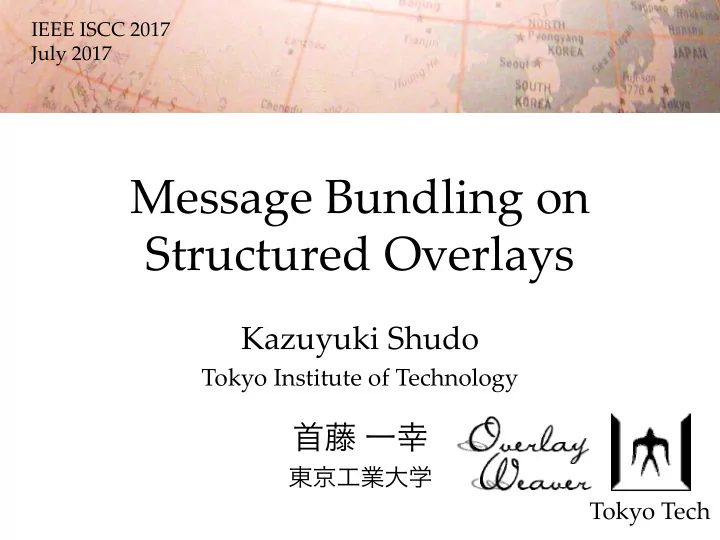

首藤 一幸 東京工業大学 IEEE ISCC 2017 July 2017 Message Bundling on Structured Overlays Kazuyuki Shudo Tokyo Institute of Technology Tokyo Tech
Background: Structured Overlay • An application ‐ level network – routes a query to the responsible node. Responsible node Index range Responsible Servers / for the requested (digest) node nodes data item ab – dz 192.168.0.2 ea – gb 192.168.0.3 gc – … 192.168.0.4 Routing table – enables scalable data store and messaging. • e.g. Distributed Hash Tables (DHT) “ Shudo ” ‘s tel # ? “+81 3 5734 XXXX ” 1 / 8
Contribution: Collective Forwarding • A message bundling technique A large amount of data for structured overlays. … … … … … … … … … … – combines multiple messages into a … … … … … … single message. Put and get – mitigates • the load of nodes on the overlay network. • the load of Internet routers on an underlay network by reducing # of packet transmission. – Results • # of packet transmission: 34 % ~ 12 % Structured overlay with many number of nodes • Data loading time: 13.0 % ~ 9.5 %
Packet forwarding Packet delivery (transmission) Message forwarding Message delivery Problem: Delivery time and underlay load Overlay • Message delivery on a structured overlay takes 1 much time. : 2 – 10,000 get operations on a DHT took 40 ~ 700 sec (Section IV.C) . 2 • An overlay imposes a : 5 burden on an underlay. Router – A message delivery requires Underlay multiple …
Proposed technique: Collective forwarding • combines multiple messages whose next hops are the same node, and forward collectively. – A requesting node has a large number of requests. e.g. DB backup 9 times # of forwarding 15 times 3 hops x 5 routes with collective forwarding 3rd hop F G H I J 2nd hop C D E Node 1st hop B Route 0 hop Node A
Proposed technique: Collective forwarding • Bundle – Messages with the same next hop. 3rd hop 1. Looks up next hops ID1 ID2 ID3 ID4 ID5 on routing table H I J Node F G 2nd hop ID1 ID2 ID3 ID4 ID5 2. Divides a bundle 1st hop D E Node C based on the next hops ID1 ID2 ID3 ID4 ID5 0 hop Next hop is node B 3. Forwards the bundles to their next hops ID1 ID2 ID3 ID4 ID5 5 messages with each target ID
Effects • On an overlay – Throughput improvement •by handling multiple messages Parallel processing of multiple messages – Load reduction of nodes • by reducing message forwarding operations. e.g. message decode/encode, routing table lookup, … • On an underlay – Packet transmission reduction Load reduction • cf. Performance of Internet routers is shown in pps (packets per second)
Initial bundle grouping • A bundle is continuously divided once forwarding starts. • How does the technique compose initial bundles? – It is not good to combine all the millions of messages. e.g. should be < MTU with UDP • Policy • In our experiments – Size – 10 – Grouping – Target ID ‐ clustered and random – When? Who? – Before routing, outside an overlay
Experiments 1. # of packet transmission on an underlay IP packet delivery from a node to another node 2. Message delivery time on an overlay • Conditions – 1000 nodes simulated on a single PC. – Overlay Weaver [Shudo 2008] • runs structured overlay routing algorithms and • simulates a distributed environment. E.g. comm. Latency – Target IDs are randomly determined. – Routing algorithms: Chord, Koorde, Pastry, Tapestry and Kademlia – Forwarding styles: iterative and recursive
# of packet transmission • Ratio to # without the technique. • Initial bundle grouping serial – “serial”: the technique better not applied. – “random” – “clustered”: target ID ‐ based clustering • Consideration – The # was reduced to around the theoretical limit 0.1. – In Kademlia, a k ‐ bucket was fulfilled Note: the forwarding style is recursive and the node sends PING msg many times. • Put and then got 50,000 data items on 1,000 nodes. • Measured the # of packet transmission on an underlay, e.g. Internet.
Message delivery time • Elapsed time to get 10,000 data items from 1,000 nodes • 1 ms of comm. latency is simulated by Overlay Weaver. • Two techniques for sec parallel processing – Collective forwarding better – Multiple (10) clients , send requests in parallel • Consideration – With concurrency 10, delivery speeded up 7.5 ~ 8.5 times. – Effects of the two techs are comparative: 7.9 sec with with 10 clients 10 clients vs. 6.9 sec. # of messages that can be processed concurrently – Effects of the two techs Bundle size (10) x # of clients, that get data from a DHT are cumulative.
Related work • Message bundling – A common technique for networks. – Investigated for various networks: wireless sensor network, DTN, virtual machines, … • MARIF [Mizutani 2013] – Bulk data transfer technique over a DHT – MARIF is dedicated to DHT, but collective forwarding works with structured overlays and supports multicast, for example. • Techniques to improve efficiency of single message delivery – Proximity routing – 1 ‐ hop DHT
Summary • Collective forwarding – combines multiple messages into a bundle and forwards it to the next hop. • Effects – Improves throughput of an overlay – Reduces # of packet transmission on an underlay • Experimental results • # of packet transmission: 34 % ~ 12 % • Data loading time: 13.0 % ~ 9.5 % – With 10 clients, 7.03 % ~ 3.12 % Tokyo Tech
Recommend
More recommend